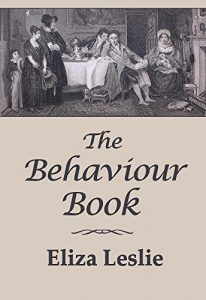Etiquette for the American middle class, 1853-style.
Eliza Leslie covers the wide range of daily life in 19th-century America: four pages are devoted to selecting an umbrella (green silk ones weren't colorfast); she includes instructions for making a good black ink; and bed-making gets half a page. It's a chatty book, full of anecdotes (George Washington telling a tall tale to a credulous traveler) and one-paragraph essays on subjects like having a bedroom window open and how to refer to black servants. (Leslie includes a disengenuous note on a noxious racial epithet.) The book is a wealth of anecdotal information about Leslie's native Philadelphia, including a child's rhyme listing its principal streets. The two chapters on how to treat writers and how to become a writer probably answered questions Leslie had heard over and over.
This ebook contains the text of the 1853 edition. Included are a review of the 1853 edition and another of the 1859 edition. I've corrected typographical errors and modernized the spelling of a few words.
Eliza Leslie covers the wide range of daily life in 19th-century America: four pages are devoted to selecting an umbrella (green silk ones weren't colorfast); she includes instructions for making a good black ink; and bed-making gets half a page. It's a chatty book, full of anecdotes (George Washington telling a tall tale to a credulous traveler) and one-paragraph essays on subjects like having a bedroom window open and how to refer to black servants. (Leslie includes a disengenuous note on a noxious racial epithet.) The book is a wealth of anecdotal information about Leslie's native Philadelphia, including a child's rhyme listing its principal streets. The two chapters on how to treat writers and how to become a writer probably answered questions Leslie had heard over and over.
This ebook contains the text of the 1853 edition. Included are a review of the 1853 edition and another of the 1859 edition. I've corrected typographical errors and modernized the spelling of a few words.






